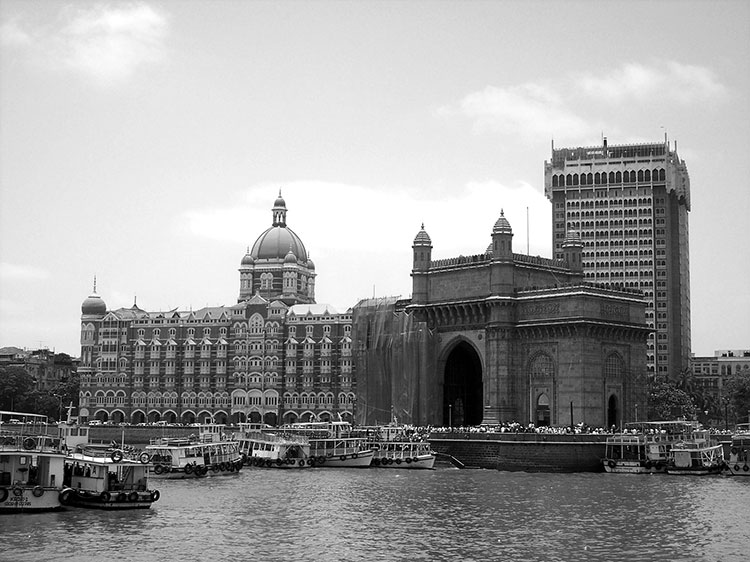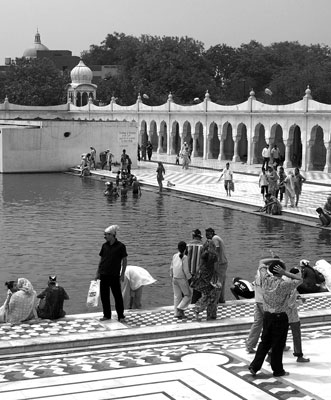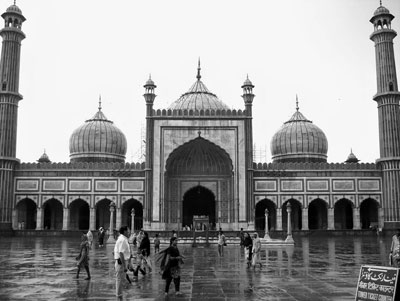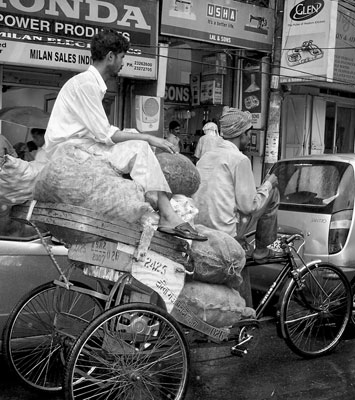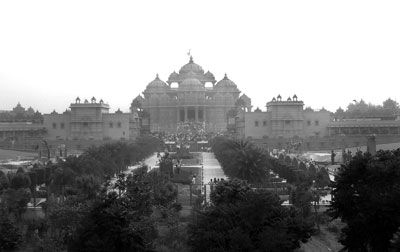Bombay & New Delhi, gateways to India
This item appears on page 78 of the September 2008 issue.
(Part 1 of 4 on India and Nepal)
India is a complex, intricate weaving of layers and textures, the essence of which is difficult to convey solely via the written word. In May 2008 I had an off-season opportunity to experience some of the best of India and Nepal on a trip hosted by SITA World Tours (an ITN advertiser) and Jet Airways.
My itinerary was similar to SITA’S 18-day tour “Best of India and Nepal” but with some modifications, including an extra night in Nepal. Itinerary inclusions were Bombay (Mumbai); the Rajasthan triangle of Udaipur, Jodhpur and Jaipur; Agra; Khajuraho; Mahua Kothi in Bandhavgarh National Park; Varanasi, and, in Nepal, Kathmandu.
Unlike on most tours, the luxury accommodation featured in SITA’s itinerary, including several famous historic palaces and hotels, was an important component of my overall India experience. Additionally, in consult with local guides, I was able to make several adjustments along the way in terms of daily touring to accommodate my particular interests.
Bombay (Mumbai)
Almost all locals still refer to their city as Bombay, so I choose to act accordingly.
It was hot and humid the first two days upon my arrival in India, but the weather did not limit my Bombay touring. My local guide, Uma, proved to be typical of the guides I would experience on my journey. All possessed graduate degrees and were very knowledgeable and engaging.
My initial touring experience was an offshore cruise to see the Elephanta Caves, one of more than 3,000 cave temples in India and considered to represent the origin of Hindu architecture. It was the first of a multitude of UNESCO World Heritage Sites I would visit.
In Bombay we toured many impressive colonial-era buildings constructed by the British, including the Prince of Wales Museum and the neo-Gothic Victoria Terminus. I particularly enjoyed visiting the Gandhi Museum, which detailed the life and times of the man who represented the soul of India. On Malabar Hill we explored a Jain temple, my second of scores of temples I was destined to visit in the coming weeks.
We returned along the beachfront to my hotel, the Taj Mahal Palace & Tower. It is located on the seafront adjacent to the famous Bombay landmark, the Gateway to India arch, built to commemorate the 1911 visit of King George V and Queen Mary.
I was accommodated in the historic old wing of the Palace, which still reflects the splendor of its early-20th-century origin. While I dined poolside, elegant colonial-era imaginings proliferated. The Palace is indeed a treat, and the ambience-rich historic old wing is definitely recommended.
Bombay is also the center of India’s enormous entertainment industry, the kingpin of which is the Bollywood film industry, several times larger than its American namesake. I was advised that approximately two films per day are completed in India, and movie ticket prices are kept very affordable for the masses.
New Delhi surprises
The gateway of New Delhi was my final stop in India, and after spending two-plus weeks of rather intensive touring on the subcontinent, my expectations for that city were muted. Happily, I experienced a virtual rejuvenation of the senses.
The broad avenues of New Delhi seemed comparatively traffic friendly, and the parklands and general abundance of trees and greenery provided a refreshing respite from my travels through drought-plagued central India.
My hotel, centrally located at Connaught Place, was the ultra-user-friendly Intercontinental The Grand, which was in the final stages of a complete, impressive ultramodern restoration. It featured excellent service, a fashionable spa and several restaurants offering differing cuisines.
Swaminarayan Akshardhan
The afternoon of my arrival in New Delhi, my driver and, by then, friend, Surya, and I visited Swaminarayan Akshardham, the eternal abode of Bhagwan Swaminarayan (1781-1830), a torchbearer of Indian spirituality and culture.
This mind-boggling cultural complex, constructed in just five years (2000-2005) on 100 acres of land in New Delhi, is a showcase of India’s traditions of art, architecture, science, wisdom and spirituality. Imagine a spiritual Disneyworld of entertainment and education complete with ornate, hand-carved sandstone temples and monuments, an IMAX theater, sunset dancing-fountain shows and much more.
My visit was on a very busy Sunday afternoon. As a result, I recommend weekdays when crowds are much smaller. Some 300-million man-hours were invested to hand carve 300,000-plus stones and create the entire complex. It is an inspiring modern architectural and cultural marvel and a must for visitors to Delhi.
Delhi touring
My full day of New Delhi/Delhi touring included many stops, the first of which was Qutab Minar, a soaring 12th-century stone tower stretching 238 feet into the heavens in a blending of Hindu and Islamic art and design. At this location my guide, Bharat, also enlightened me regarding the multiple medicinal properties of India’s prolific Neem tree.
Our next stop was Jama Masjid, India’s largest mosque, constructed in 1656. The feel walking around the grounds was decidedly Muslim and invited reflection on the range of religious philosophies that coexist in modern India.
We ventured on to Humayun’s Tomb (1656), a prime example of early Mughal architecture and forerunner to the world-famous Taj Mahal. On site are more than 100 tombs.
At the Gandhi Memorial Museum, I indulged self interest, allowing time to meditate at the site of Gandhi’s 1948 assassination. A fascinating, detailed history of that time in India was portrayed on wallboards in a setting I felt personally to be abundant with both revenant and reverent energy.
Next up was a driving excursion of Raisina Hill, the heart of New Delhi and India’s political center. Featured were Parliament House; the Presidental Palace with its striking Mughal Garden; the National Museum; the National Archives, and the National Gallery of Modern Art. A drive down Raj Path reveals the imperial splendor of the area, culminating at India Gate, which honors early-20th-century Indian war dead.
Finally, I received yet more purification at a 17th-century Sikh temple, where I learned about that sect’s more-inclusive-of-all-beliefs religious philosophy.
In part two of this series on India, the lavish palaces and other treasures of alluring Rajasthan will be unveiled.
Efficient air connections
En route to and from India, I experienced and was impressed with both the premiere (business) and economy classes of service aboard Jet Airways (877/835-9538, www.jetairways.com).
The cabin service was easily superior to what I typically experience on American carriers. The route structure from the East Coast of the U.S. allows departures from both Newark and JFK airports, with all flights routing through Brussels. The onward flights continue to either Delhi or Bombay, allowing maximum itinerary flexibility.
Jet Airways also has service to India from San Francisco via Shanghai and operates a significant network of India domestic and regional flights.
Expeditious passport services
In April I found myself in the hurried and harried situation of needing to have extra pages added to my passport and obtaining a visa for India. In this tight timing circumstance, Passport Nation (800/643-4777, www.passportnation.com) came to the rescue.
Flawlessly navigating my passport through dual bureaucracies in what seemed record time, they earned my gratitude and recommendation.
Their rates range from $95 and upward for 12- to 15-day standard passport services. The rates for a visa are $75 for standard service and $100 for expedited service.
India information
SITA World Tours (Encino, CA; phone 800/421-5643, e-mail sitatours@sitatours.com or visit www.sitatours.com) offers an extensive range of luxury, deluxe, first-class and independent-traveler itineraries to India and worldwide.
Keck's Beyond the Garden Wall
❝A lucent feast for the senses. ❞
— Randy’s parsimonious encapsulation of his experience of India

